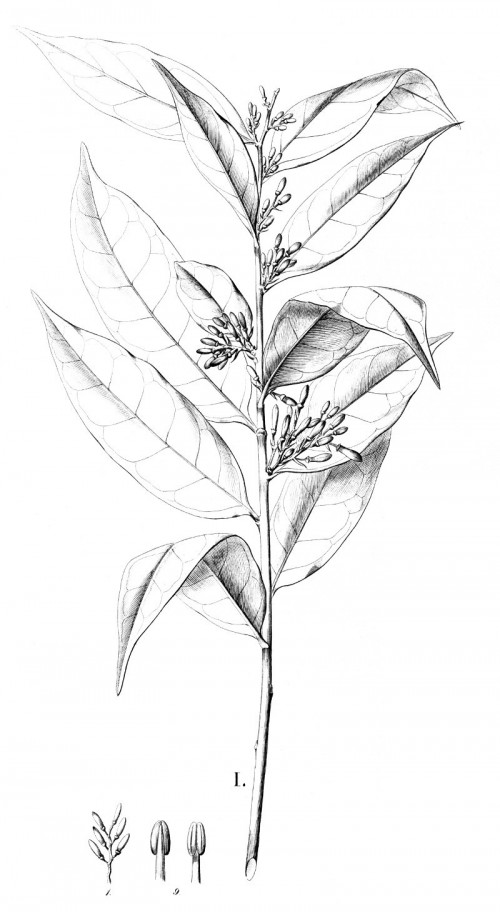Ptychopetalum olacoides Benth. - Oleaceae - muira-puama (port.), potency wood, Potenzholz
Tree, up to 15m high, native to South America (Guyana, Surinam, Brazil).
The roots were used by the Amerindians of the Amazonas forest to treat paralysis, dyspepsia, menstrual cramps, and impotence.
[Die Stammpflanzen der Droge Muira-puama., Anselmino, E., Notizblatt des Botanischen Gartens und Museums zu Berlin-Dahlem, 1932, 623-626]
The root bark contains lupeol (up to 0.5%), mostly as ester of behenic acid (61%). Dried wood and roots of the tree (also from Liriosma ovata other Ptychopetalum species) provide the commercial pharmaceutical drug 'Muira puama lignum' (potency wood) which is traded as aphrodisiac although this effect is unproven.
[Der lipophile Inhaltsstoff von Muira puama 3., Auterhoff, H., Momberger, B., Mitt. Archiv der Pharmazie, 304(3), 1971, 223-228.]
[Hagers Handbuch der Pharmazeutischen Praxis, Springer 2010]
„Decoctions of the root and stem bark of Ptychopetalum olacoides Benth., Olacaceae, have been used in folk medicine for their aphrodisiac, appetite modulator and anti-tremor properties. Additionally, the plant is claimed to act as a nerve tonic by promoting recovery of cognitive and motor functions after brain injuries (including strokes) and cognition improvement (particularly alertness and memory) in the elderly.
… HPLC-UV/PAD profiles of bark and commercial extracts of P. olacoides were examined, and a protocol for the isolation and purification of three compounds present in all of the analysed extracts was elaborated. The common components were identified by NMR as vanillic acid, protocatechuic acid and theobromine, the former of which has been proposed as a phytochemical marker for P. olacoides.“
[CValidated high-performance liquid chromatographic method for the standardisation of Ptychopetalum olacoides Benth., Olacaceae, commercial extracts., olombo, R., Batista, A.N.D.L., Bomfim, G.C., Burgos, R.C., Cavalheiro, A.J., Bolzani, V.D.S., Reimberg, M.C.H., Revista Brasileira de Farmacognosia, Vol.20(5), 2010, 781-788]
http://www.scielo.br/scielo.php?pid=S0102-695X2010000500021&script=sci_arttext
„The continual exploitation of this Amazon endemic species, the use of roots, and the lack of incentives to cultivate it to supply this demand must have led to significant reduction of its natural populations. When such a situation arises, usually the market seeks alternative sources of supply, eventually triggering the replacement of the true species by another with the same indications, although it may not always be chemically similar, as occurred with the catuaba. In the case of P. olacoides, the commercial substitution led to exploitation of stems, which were initially offered as being from the species itself, as a strategy to prevent the destruction of the specimens by removal of the roots, as reported by plant drug distribution companies. However, it was gradually found that these stems came from the interior of the state of Bahia, probably originating from some species of Croton, Euphorbiaceae, and were completely different from the Amazon Marapuama.“ [but Croton echioides, the Northeastern Marapuama, also contains lupeol]
[Morphoanatomy and pharmacognostic study of the wood of Croton echioides, the Northeastern Marapuama., Novello, C.R., Marques, L.C., Miyazaki, C.R., Milaneze-Gutierre, M.A., Carneiro-Torres, D.S., Sarragiotto, M.H., de Mello, J.C., Revista Brasileira de Farmacognosia, Vol.22(5), 2012, 946-956]
http://www.scielo.br/scielo.php?pid=S0102-695X2012005000062&script=sci_arttext

Martius, C., Eichler, A.G., Urban, I., Flora Brasiliensis, vol.12(2): f.60, t.3 (1872)
http://plantgenera.org/species.php?id_species=853300
